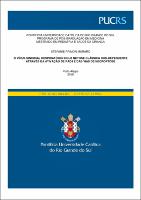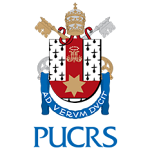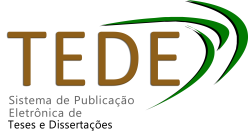| Share record |


|
Please use this identifier to cite or link to this item:
https://tede2.pucrs.br/tede2/handle/tede/8083| Document type: | Dissertação |
| Title: | O vírus sincicial respiratório induz NETose clássica ROS-dependente através da ativação de PAD4 e das vias de necroptose |
| Author: | Muraro, Stefanie Primon  |
| Advisor: | Porto, Bárbara Nery |
| Abstract (native): | O vírus sincicial respiratório (VSR) é uma das principais causas de doenças do trato respiratório em humanos sendo associado principalmente com bronquiolite, doença pulmonar obstrutiva crônica (DPOC) e exacerbação de asma. O VSR infecta principalmente células epiteliais pulmonares e, uma vez que a infecção é estabelecida, uma resposta imune inata é desencadeada e ocorre o recrutamento de células do sistema imune, principalmente neutrófilos. Os neutrófilos podem liberar redes extracelulares de neutrófilos (NETs) capazes de capturar e inativar uma grande quantidade de microrganismos devido à sua composição e natureza fibrosa das fibras de DNA. Recentemente, foi demonstrado que partículas do VSR além da proteína de fusão (F) do vírus foram capazes de induzir a liberação de NETs revestidas com elastase neutrofílica e mieloperoxidase, ambos peptídeos com atividade antimicrobiana. Além disso, observou-se que a formação excessiva de NETs pode ter consequências negativas para o hospedeiro, como a obstrução das vias aéreas durante a infecção por VSR. Portanto, o objetivo foi avaliar os mecanismos envolvidos na formação de NET induzida pela infecção por RSV em neutrófilos humanos, células epiteliais alveolares (A549) ou fibroblastos pulmonares (MRC5). Neutrófilos humanos foram infectados com VSR e foram capazes de induzir a liberação de NETs somente após 3 horas de infecção, indicando uma NETose clássica. Em seguida, foi caracterizada a formação de NETs durante a infecção associando a extrusão de DNA com as proteínas MPO, NE e com a proteína F do VSR. Também se observou a dependência de NADPH oxidase e PAD4 e das vias de sinalização PI3K / AKT, ERK e p38 MAPK durante a infecção. A inibição dessas vias de sinalização, da produção de PAD4 e de EROs aboliu a formação de NET. Considerando um possível envolvimento da necroptose na produção de NETs, foram utilizados inibidores de MLKL e RIPK1 e foi avaliada a liberação de LDH no sobrenadante de neutrófilos infectados. Os neutrófilos liberaram LDH e dependeram da ativação da necroptose para produzir NETs. Do mesmo modo, os neutrófilos foram co-cultivados com células A549 ou MRC5 infectadas com VSR. Ambas as células A549 e MRC5 desencadearam a liberação de NET por neutrófilos humanos de uma maneira dependente da concentração de vírus, o oposto ocorreu quando usado um vírus UV-inativado. Resumidamente, o VSR induz a NETose clássica / dependente de EROs em neutrófilos humanos, e este efeito depende de atividade específica de quinases. Além disso, os neutrófilos são capazes de reconhecer células pulmonares infectadas pelo VSR, induzindo a liberação NETs. Assim, o controle de liberação de NETs pode ser crucial para minimizar a inflamação do tecido causada pela infecção por VSR. |
| Abstract (english): | Respiratory syncytial virus (RSV) is a major cause of diseases of the respiratory tract in humans being mainly associated with bronchiolitis, chronic obstructive pulmonary disease (COPD) and asthma exacerbation. RSV infection occurs primarily in pulmonary epithelial cells and, once infection is established, an innate immune response is triggered and mainly neutrophil recruitment is induced. Neutrophils can extrude neutrophil extracellular traps (NETs) capable of entrapping and inactivate a multitude of microorganisms because of its composition and due to the stringy nature of DNA fibers. Recently, was demonstrated that RSV particles and its fusion (F) protein were able to induce the release NETs coated with neutrophil elastase and myeloperoxidase, both antimicrobial peptides. Also, was observed that the excessive formation of NETs can have negative consequences to the host, such as airway obstruction during RSV infection. Therefore, the aim was to evaluate the mechanisms involved in NET formation induced by RSV infection of neutrophils, alveolar epithelial cells (A549) or lung fibroblasts (MRC5). Human neutrophils were infected with RSV and were able to induce NETs release only after 3 hours of stimulation indicating classical NETosis. Next was characterized NETs formation during infection associating DNA extrusion with MPO, NE and F protein of RSV. Was also observed NADPH oxidase and PAD4 dependence and PI3K/AKT, ERK and p38 MAPK pathways during infection. The inhibition of these signaling pathways, PAD4 and ROS production abolished NET formation. Considering a possible involvement of necroptosis during NETs production, were tested MLKL and RIPK inhibitors and evaluated LDH release in the supernatant of infected neutrophils. Neutrophils released LDH and depend on necroptosis induction to produce NETs. Likewise, neutrophils were co-cultured with A549 or MRC5 cells infected with RSV. Both A549 and MRC5 cells triggered NET release by human neutrophils in a virus concentration-dependent manner, the opposite occurs when used UV-inactivated virus. Briefly, RSV induces the classical/ROS-dependent NETosis by human neutrophils, and this effect relies on specific kinases activity. Furthermore, neutrophils are able to recognize pulmonary cells infected by RSV, releasing NETs. Thus, NETs release control could be crucial for minimizing tissue inflammation caused by RSV infection. |
| Keywords: | NETose Clássica Necroptose MAPK- Proteíno-Quinases Ativadas por Mitógeno Vírus Respiratório Células Epiteliais Classical NETosis Necroptosis MAPK- Mitogen-Activated Protein Kinase Respiratory Virus Epithelial Cells |
| CNPQ Knowledge Areas: | CIENCIAS DA SAUDE::MEDICINA |
| Language: | por |
| Country: | Brasil |
| Publisher: | Pontifícia Universidade Católica do Rio Grande do Sul |
| Institution Acronym: | PUCRS |
| Department: | Escola de Medicina |
| Program: | Programa de Pós-Graduação em Medicina/Pediatria e Saúde da Criança |
| Access type: | Acesso Aberto |
| Fulltext access restriction: | Trabalho será publicado como artigo ou livro |
| Time to release fulltext: | 60 meses |
| Date to release fulltext: | 28/05/2023 |
| URI: | http://tede2.pucrs.br/tede2/handle/tede/8083 |
| Issue Date: | 16-Mar-2018 |
| Appears in Collections: | Programa de Pós-Graduação em Pediatria e Saúde da Criança |
Files in This Item:
| File | Description | Size | Format | |
|---|---|---|---|---|
| DIS_STEFANIE_PRIMON_MURARO_COMPLETO.pdf | STEFANIE_PRIMON_MURARO_DIS | 4.32 MB | Adobe PDF |  Download/Open Preview |
Items in DSpace are protected by copyright, with all rights reserved, unless otherwise indicated.




